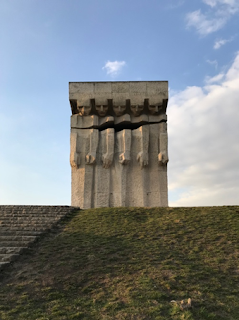This picture was taken on March 19th in Auschwitz ll - Birkenau. In this picture many different things are going on. Not only at the time this picture was taken but also the history behind this sight pictured above. This picture was taken in Auschwitz ll - Birkenau was one of the largest concentration and death camps of the Holocaust or the Shoah. The site of this picture was in the far back of Auschwitz ll – Birkenau, away from all of the prisoner and surrounding homes and civilians. No one would know this was here from the outside. What you cannot see in this picture is that to the left, outside the view of the picture, is the gas chambers and crematoriums. The water in the background of this picture is a little pond. Prisoners were sent to their death in these gas chambers and crematoriums. The officers of the camps would dispose of the prisoner's ashes in to this little pond. This is a horrible disregard for human life. In front of the little pond there are four large black stones with an inscription on it. The inscription said “To the memory of the men, women and children who fell victim to the Nazi genocide. Here lie their ashes. May their souls rest in peace”. Each one of the four stones had this same inscription on it in four different langue's, so that many different people can read the inscriptions and pay their respects. The four languages are English, Polish, Yiddish, Hebrew. At the site of this picture we did a memorial service with our class and guide, in front of the stones. We read a Holocaust remembrance prayer as our memorial service. We took turns reading lines from the prayer. This was a very important service to me because I have family and friends who have lost loved ones in the Holocaust. In class we have learned about the importance of remembrance. It is important to remember the horrific events that have taken place during the Shoah. We must remember and honor the men, woman, and children who have lost their lives during the Holocaust. We also must remember these horrific events of the Shoah so that we can ensure that genocides live this or genocides at all happen again. Memorial services of all kinds are important in order to pay respects and remember those who lost their lives and these horrific events. Whether these memorial services are small like the ones our class had throughout our trip, or like the memorial service our class will be having at Iona college, or they are nationwide services they are all extremely important to show our respects to those impacted by these events and to show remembrance.



















